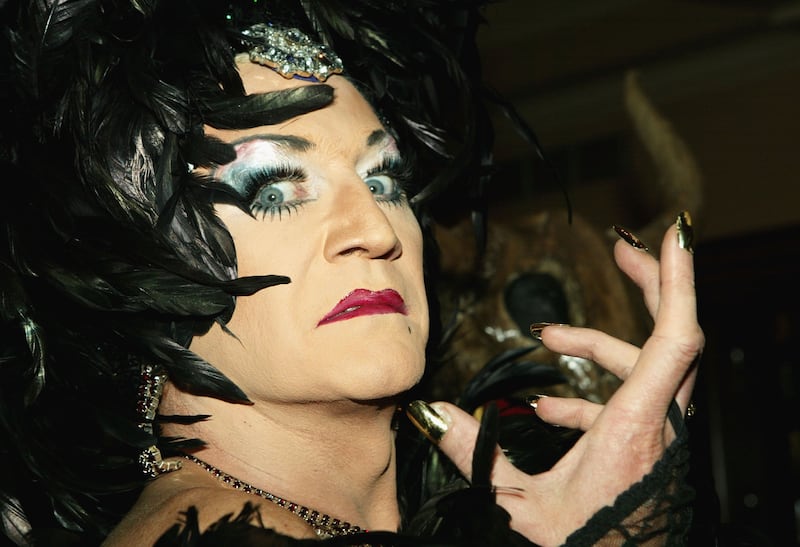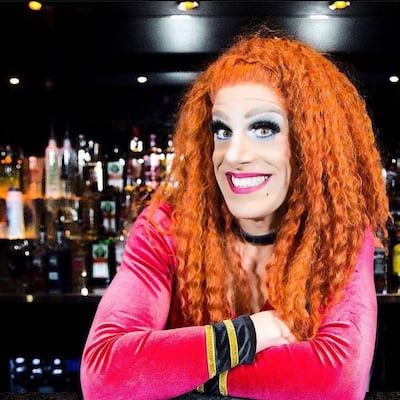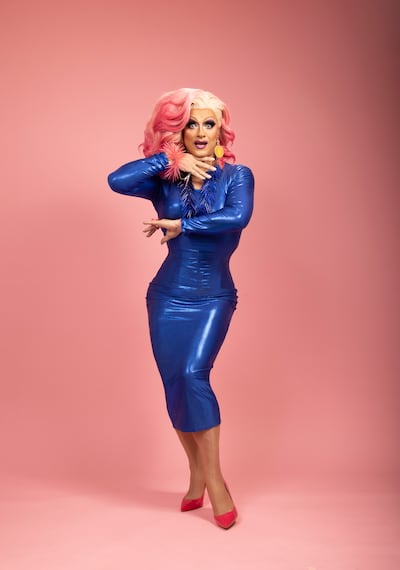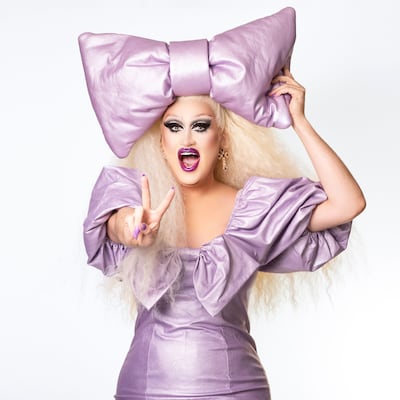I was 16, the first time I crept into a club to watch a drag show.
I was a highly trained classical musician, the pride of my school, successful in competitions and performing professionally, but there was no Pride in me. Young and a bit lost, I’d buried myself in work. I knew I was bisexual, but I didn’t have the emotional skills of self-defence to thrive, growing up queer in the 70s and 80s.
I saw a poster on a wall, a drag queen. I went alone. My heart was beating fast as I walked up the steps. I kept expecting someone to tap me on the shoulder and tell me I wasn’t meant to be there. The club was dark, thick with smoke, packed with people. A bright light hung over the stage. The curtains were torn. The speakers hissed and rattled. Then a door on the left opened to reveal a shimmering wonder, and my world changed forever.
She was incredible – tall, full of life, and extremely loud. She wore a velvet purple dress with ruffles at the neck, a huge curly wig, and her make-up looked like it had been applied by the back of a spoon, and she gave absolutely no… let’s call it huffs… she gave no huffs, as to what anyone else thought. She ruled from that stage. She was funny and quick, and a truly terrible singer, and the audience adored her. I fell head over heels in love.
She sang a show tune I vaguely recognised with the lyrics rewritten, but it was the banter between the numbers that I loved. Only the brave or the very drunk tried heckling, and they were ripped to shreds – not just a simple take down, this incredible queen tore them apart in a way I had never seen before. I realise now that she probably knew the hecklers – that this was all the spirit of the night – but then, at 16, I thought she was the coolest person I’d ever seen.
She argued with everyone. The crowd. The bar staff. The speakers screamed with feedback when she stepped too close with her mic in her hands, and she’d shout at the sound system as if it had a will of its own; the lighting flickered and earned itself another tirade of insults.
I wish I could remember her name; I’d send her something to say thank you – flowers maybe. Vodka, more like.
I went back the next week. And the next. The queens were so strong, so regal. They were funny and sassy and smart. I waited to speak to Regina Fong at the end of one of the shows and I told her how I loved watching her. “Thank you very much,” she said. “I’m just a man in a dress.”
Drag took one look at the rules and smashed them under a size 12 stiletto
I found a whole world of wonder, like stepping through the looking glass. Not just drag queens, who were mostly men dressed as women, but drag kings too, women dressed as men. Now, things are less binary and we have drag from all genders, in all styles. But then it was a wake-up call to me that the world was a marvellous place.
Drag, for me, became strength. The shadows in the London clubs could easily hide someone who didn’t really look 18 and certainly wasn’t cool. I could sip on my vodka and coke and watch the show. Drag wasn’t so much all-inclusive then, as all-excluding. Everyone, no matter who you were, was up for a takedown. The performers could say things they might never say out of drag.
I have been lucky with my family, both born and found, but by 16 I’d learned that as far as society was concerned, the things I was feeling were considered “wrong”. I was “wrong”. It’s a lie that words will never hurt you. Words get under your skin and they rot your soul. Like hecklers, bullies don’t want to be seen. They want to be heard, yelling from the darkness. Watching the queens take on their hecklers, I could fight back with my own predators.
I longed to strut like Lily Savage, or speak out like Panti. To have the stage presence and power of Shirley Temple Bar
Sometimes I’d meet friends there, but mostly I liked to go alone. The dress, the make-up, the attitude, the sass – drag said everything I wanted to say and yet I couldn’t shape back then, into words – it was performance and protest, a middle finger lifted to the establishment.
The 80s and 90s were a terrifying time in the LGBTQ+ community. HIV and Aids ran through our friends and family, and governments on all sides of the world chose to ignore it, and to let people die. Thanks to incredible hard work from many people, HIV is now a status and not a death sentence. But then, in the dark years, we were told that as a community, we didn’t matter.
But drag doesn’t stop for anyone. Not for governments, and not for pandemics. The bars I went to were louder, more fabulous. The clubs were wild. Drag was about standing up, strong; it was all about the performance. Whatever else was happening in the world, Lily Savage would always make me laugh. Regina Fong would come out in some hideous frock and big orange wig, and the world was a better place.

I saw this strength on the club stages over and over again as I crept in and hid in the shadows to watch the shows. The fearlessness and confidence that shone from the performers, started to live in me, a tiny bit. In those wonderful, dark, musty bars, I found friendship and love, and acceptance.
Drag took one look at the rules and smashed them under a size 12 stiletto.
I’m not 16 any more and I’m no longer looking for a guardian or a defender, but I still love watching drag. I love to laugh; funny is a skill, and there’s nothing better than feeling the world slip away with the click of heels on the stage, a flash of sequins and glitter.
The homophobes and the bigots can bleat all they like, just as they always have, but drag is stronger than that. Drag is powerful
I switched from London to Dublin when I moved across the water 20 years ago and my eyes were opened to Irish drag. I hadn’t lived until I saw Dolly Grip performing Big Spender. We have world class acts on stage every night of the week in Dublin now, from Victoria Secret and Davina Devine, Veda and Pixie Woo, and the incomparable Panti Bliss, to the internationally adored drag king Phil T Gorgeous whose charm and charisma melts many a heart darker than mine.

As often as I can, I take a run up to Dublin to catch a live show. On Sunday nights, the stage at The George is filled with performers for Shirley Temple Bar’s drag bingo. It’s the most fun you can have without breaking out the strawberry sauce.
I brought my best friend to bingo last year and Shirley flung cheese at her head. But don’t let that put you off – Shirley Temple Bar is an icon. A goddess in a dress. She’s everything I have always loved about drag. She rules the stage. She’s funny and clever and brilliant, and I’m terrified of her, with or without cheese.
A true star, an idol, is always that little bit scary. Panti Bliss, whose speech on oppression and homophobia from the Abbey Theatre should be part of the education curriculum (and compulsory viewing for all), fills me with awe. On stage she’s a powerful performer but it’s her fight that I love.
As a teenager I hid in the shadows. Now, I am cheering from the front row
I wish I’d had that power to take my words and fight with them, when I was 16. I longed to strut like Lily Savage, or speak out like Panti. To have the stage presence and power of Shirley Temple Bar.

The first time I saw Bianca Del Rio, winner of season six of Ru Paul’s Drag Race, on stage, I hadn’t watched the TV show or seen her posts on social media. I was late to the new wave of drag. I was in a club in Dublin to see Victoria Secret, and Bianca was the big name of the night.
The lights dimmed, the spotlight picked out the stage and the crowd went wild. In all my life of watching drag shows and comedy shows, I’ve never seen anyone take on a stage like Bianca. Wickedly funny and extremely fast, she is a force to be reckoned with. She has the dirtiest laugh. And she has the magic that shines in Lily and Shirley, the power and confidence of self. A woman near me turned to her companion and said, “I wish Bianca was my best friend.”
On the surface, the world has got better for LGBTQ+ people since I was a teenager: we can marry who we love, we can be who we are, we can introduce our partners of all genders on Pointless. Insurance companies give payouts to gay partners. Queer parents are allowed in foster care. It’s nearly safe to come out as queer in sport. Pride became commercialised. From vodka to airlines to taxis to celebrity podcasts, companies embraced their rainbow colours for the month of June, yet turn a cheek to the rampant transphobia and fear mongering in the press for the rest of the year.

The bitter comments never stopped; the same old pain is still there for the LGBTQ+ community. Whilst Drag Race is on the telly with series after series, out in the real world, we’re slipping back into the dark ages of brutal homophobic attacks, of judgment and unkindness rife in politics, of bigotry in schools and workplaces.
It’s a shameful side of humanity when fear rules and part of the population is made to feel different. Less than.
There is nothing less about drag. The homophobes and the bigots can bleat all they like, just as they always have, but drag is stronger than that. Drag is powerful.
I still get the same rush of delight as the music starts and the spotlight comes on over the stage.
As a teenager I hid in the shadows. Now, I am cheering from the front row. I’m not looking for a godmother in sequins any more, but when Shirley Temple Bar is on stage doing ABBA’s Gimme Gimme Gimme, then the world is a brighter place, and I’m happy. And that’s a wonderful gift.
Kitty Murphy’s debut novel Death in Heels, a murder mystery set in a fictional Dublin drag club, is published by Thomas & Mercer











